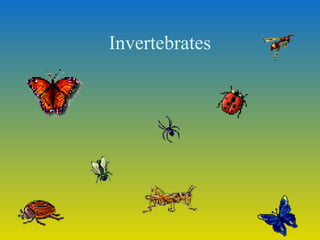
Animal classification invertebrates 5th grade
- 2. Invertebrate Characteristics Invertebrate animals have no inner skeleton or backbone. SIZE: most invertebrate are very small, but some are enormous, like the giant squid. BODY COVERING: some invertebrate bodies are protected by shells or exoskeletons, but others have no covering
- 3. Invertebrate Characteristics BODY SHAPE: most invertebrates are symmetrical: - Bilateral symmetry: two identical halves or planes - Radial symmetry: several planes of symmetry - Asymmetry: the body has no symmetry. It is irregular
- 4. WHERE AND HOW INVERTEBRATES LIVE Many invertebrates live in the sea, but some live in fresh water, and others on land. Most invertebrates can move. However, some don’t move: they attach themselves to rocks or the sea floor. Parasites live inside of other animals and harm them Most invertebrates are oviparous. A larva hatches from an egg.
- 6. Sponges Sponges: have irregular bodies and no symmetry. They cannot move around. They attach themselves to rocks or the sea floor. They filter seawater and retain the nutritive substances for food.
- 7. Cnidarians Cnidarians: have jelly-like bodies with radial symmetry. They have tentacles. They are marine animals. Some, like coral and sea anemone, attach themselves to rocks. Others, such as jellyfishes, can move about .
- 8. Worms: Flatworms, Roundworms, and Segmented worms Worms have soft bodies with bilateral symmetry. Some are cylindrical, but others are flat. Some worms are aquatic and others are terrestrial. Many are parasites
- 9. Echinoderms Echinoderms have five-way symmetry. They have a skeleton made of hard plates, often with spines. They are covered by a thin skin. All are marine animals
- 10. Molluscs Molluscs have a soft body with bilateral symmetry. Many are covered with one or two shells.
- 11. Arthropods Their bodies are totally covered by an articulated exoskeleton, like armour. Some are aquatic and some others are terrestrial
- 12. GROUP OF ARTHROPODS CHARACTERISTICS: - The exoskeleton is like a human skeleton, it protects the body, but it is external. - The exoskeleton is rigid, so from time to time the arthropod moults ( changes the skin) and grows a new one. This process is called moulting. - Arthropods sense organs are well developed. They have antennae and eyes. The eyes can be simple or compound. Compound eyes are made up of thousands of smaller, simple eyes. - Insects, arachnids, crustacean and myriapods are arthropods.
- 13. GROUP OF ARTHROPODS INSECTS Insects are the most numerous animal group. An insect body id divided into three parts: head, thorax and abdomen. The head has a mouth, two eyes and two antennae. The thorax has six legs. Many insects have wings on the thorax
- 14. GROUP OF ARTHROPODS INSECTS II Insects can live everywhere except the open sea. They eat many different types of food. Some insects, like bees or silkworms, produce substances which are useful for people. Others are harmful, they cause illness, destroy crops or spoil food.
- 15. GROUP OF ARTHOPODS ARACHNIDS These arthropods have eight legs. An arthropod body is made up of two parts: the abdomen and the cephalothorax. Scorpions and spiders are arachnids. Most are terrestrial, and some are carnivorous. They hunt and eat other animals.
- 16. GROUP OF ARTHOPODS CRUSTACEAN Most crustaceans are aquatic. Many have ten legs, two pairs of antennae and compound eyes. The body is made up of two parts: abdomen and the cephalothorax. Many crustaceans are used for food: lobster, shrimp and crabs, for example
- 17. GROUP OF ARTHOPODS MYRIAPODS These arthropods have long bodies made up of many identical segments. Each segment has one or two pairs of legs. The head has two short antennae CENTIPEDE
- 18. GROUP OF MOLLUSCS They have soft bodies protected by one or more shells. Most molluscs are aquatic, but a few live on land. There are three principal groups of molluscs: Gastropods, bivalves and cephalopods
- 19. GROUP OF MOLLUSCS GASTROPODS I Gastropods have a head with four tentacles, where the sense organs are located. They have one foot to move. Marine gastropods eat algae, but most terrestrial gastropods are herbivores Most gastropods have one spiral shell which protects their internal organs. Some, however, have no shell: slugs, for example.
- 20. GROUP OF MOLLUSCS BIVALVES Bivalves have a shell made up of two articulated valves. The valves can open and close. Bivalves have a soft body, but no head Some bivalves, like mussels, attach themselves to rocks on the ocean floor. Other like oysters, move around. To obtain food, bivalves filter salt water and retain the nutritive substances
- 21. GROUP OF MOLLUSCS CEPHALOPODS Cephalopods have a well –developed brain. They have eight or ten tentacles. All cephalopods are marine. They move their body and expel water to go from one place to another. Some of them have a very small internal skeleton, called a cartilage. Cephalopods are carnivorous, they capture their prey with the tentacles